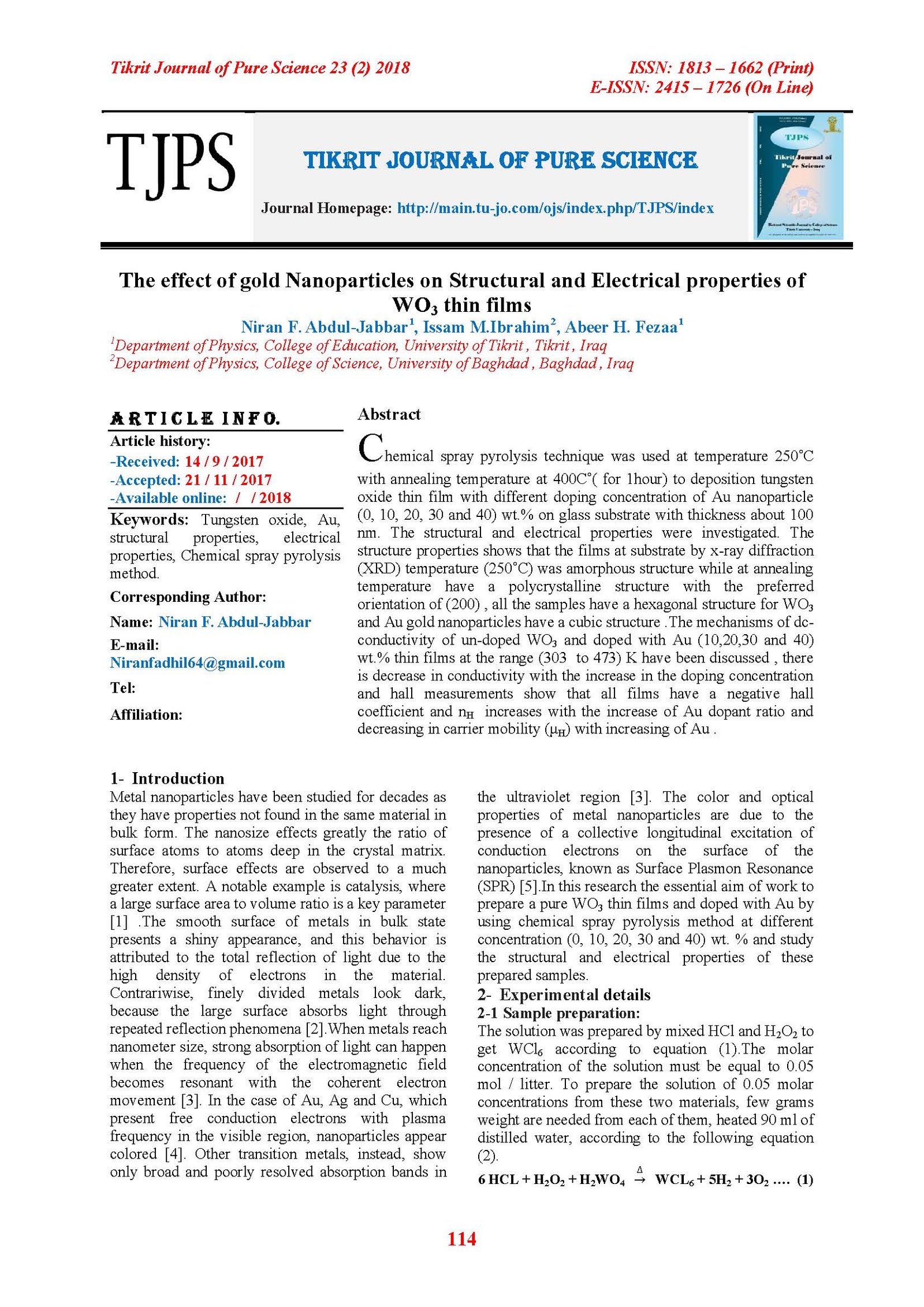The effect of gold Nanoparticles on Structural and Electrical properties of WO3 thin films
Main Article Content
Abstract
Chemical spray pyrolysis technique was used at temperature 250˚C with annealing temperature at 400C˚( for 1hour) to deposition tungsten oxide thin film with different doping concentration of Au nanoparticle (0, 10, 20, 30 and 40) wt.% on glass substrate with thickness about 100 nm. The structural and electrical properties were investigated. The structure properties shows that the films at substrate by x-ray diffraction (XRD) temperature (250˚C) was amorphous structure while at annealing temperature have a polycrystalline structure with the preferred orientation of (200) , all the samples have a hexagonal structure for WO3 and Au gold nanoparticles have a cubic structure .The mechanisms of dc-conductivity of un-doped WO3 and doped with Au (10,20,30 and 40) wt.% thin films at the range (303 to 473) K have been discussed , there is decrease in conductivity with the increase in the doping concentration and hall measurements show that all films have a negative hall coefficient and nH increases with the increase of Au dopant ratio and decreasing in carrier mobility (μH) with increasing of Au .
Article Details

This work is licensed under a Creative Commons Attribution 4.0 International License.
Tikrit Journal of Pure Science is licensed under the Creative Commons Attribution 4.0 International License, which allows users to copy, create extracts, abstracts, and new works from the article, alter and revise the article, and make commercial use of the article (including reuse and/or resale of the article by commercial entities), provided the user gives appropriate credit (with a link to the formal publication through the relevant DOI), provides a link to the license, indicates if changes were made, and the licensor is not represented as endorsing the use made of the work. The authors hold the copyright for their published work on the Tikrit J. Pure Sci. website, while Tikrit J. Pure Sci. is responsible for appreciate citation of their work, which is released under CC-BY-4.0, enabling the unrestricted use, distribution, and reproduction of an article in any medium, provided that the original work is properly cited.
References
[1] Dugleux, P. and de alameda marques, S., " preparation of metal powders of groups VI and VIII (Fe, Co, Ni) by the vapor phase reduction of their chlorides pure or in binary mixtures", Powder Technology,.27 (1), 45–52,(1980) .
[2] J. Jakobi, A. Menéndez-Manjón, V.S.K. chakravadhanula, L. Kienle, P. Wagener, S. Barcikowski, Nanotech "stoichiometry of alloy nanoparticles from laser ablation of Pt Ir in acetone and their electrophoretic deposition on Pt Ir electrodes" 22, 145601-145607, (2011).
[3] J. Jakobi,S. Petersen, A. Menéndez-Manjón, P. Wagener, S. Barcikowski, "magnetic alloy nanoparticles from laser ablation cyclopentanone and their embedding in to aphotoresist", langmuir ,26(10), 6892–6897,(2010).
[4] W.G. Zhang, Z.G. Jin, "research on successive preparation of nano-FeNi alloy and its ethanol sol by pulsed laser ablation"Sci. China Ser. B,( 47), 159-165,(2004)
[5] D. Poondi, T. Dobbins, J. Singh," anovel laser liquid soild interaction
technique for synthesis of silver, nickel and immiscible silver nickel alloy from liquid processors", J. Mater. Sci., 35(24), 6237-6243, (2000). [6] Lai, Wei Hao, "Synthesis of tungsten oxide particles by chemical deposition method. " Materials transactions 48 (6) , 1575-1577, (2007).
[7] Dong-myong,"Full Open Access Journals Have Increased Impact Factors Molecular "Diversity Preservation International, 12 (5), 519-528,(2005).
[8] Akl et al., "microstructural and electrical properties of (WO3) 1-x (MoO3) x thin films synthesized by spray pyrolysis technique " Journal of Material Sciences (2321 – 6212), (2016) .
[9] Ganbavle, "structural, optical, electrical and dielectric properties of the spray deposited WO3 thin films" journal of materials engineering and performance, 23 ,1204-1213, (2014).
[10] H .Rezvani, "the effect of deposition parameters on the sensing behaviors of the Sno2:Cu nanostructure thin films including Co2 gas sensor" Indian journal of science, 3(6), 0974- 6846, (2010).
[11] Lijun Li, Kera, a- Zheng Tang, Ziqiang Zhu, and Qing Wan,"room temperature ferromagnetism properties of Cu doped nanowires" Journal of Applied physics, 107, 014303, (2010) .
[12] Jae Cheon Sohn, Sung Eun Kim, Zee Won Kim, and Yu "transactions on electrical and electronic materials, 10, 4, (2009).
[13] Joseph, V.Mathew, and K.E Ibrahim, Chinese Journal of physics, 45(1),(84-97) (2007).
[14] Sitrotin, Y. and M. Shaskolskaya, "Fundamental of crystal physics", Mir publishers, Moscow, (1982) .
[15] P.S. Kireev, "Semiconductor Physics", Translated from Russian by M. Samokhvalov, MIR publishers, Moscow (1978).
[16] Yadav, A. A. and E.U. Masumdar, “Optical and electrical transport properties of spray deposited CdS1-xSex thin films”, Journal of Alloys and Compounds, 505, (787–792), (2010).
[17] Prabahar, S., N. Suryanarayanan and D. Kathirvel," electrical and photoconduction studies on chemical bath deposited cadmium sulphide thin films”, Chalcogenide Letters, 6 (11), (577-581), (2009).
[18] A. Salah Hamead, "electronic properties of the A-Ge/C-Si Heterojunction", M.SC., Thesis, Baghdad University, (2009).
[19] R.S. Vemuri, K. Kamala Bharathi, S.K. Gullapalli, C.V. Ramana, Appl. Mater.
Interfaces 9, 2623 (2010).
[20] M.G. Hutchins, O. Abu-Alkhair, M.M. El-Nahass, K. Abdel-Hady," electrical conduction mechanisms in thermally evaporated tungsten trioxide WO3 thin films" J. Phys. Condens. Matter 18, 9987 (2006).
[21] Ganbavle et al., "Structural, Optical, Electrical, and Dielectric Properties of the Spray-Deposited WO3 Thin Films", Springer, Journal of materials engineering and performance, 23, 1204-1213, (2014).
[22] S. K. and S. G. Vijaykumar.B.Chanshetty1, “Surface Morphology Studies and Thermal analysis of V2O5 doped polyaniline composites,” Int. J. Eng. Res. Appl., 2( 5), 611–616, (2012).
[23] H. Kim, C. M. Gilmore, "electrical , optical and structural properties of indium tin oxide thin films for organic light emitting devices" J. Appl. Phys., 86 (11) 6451– 6461, (1999).
